Currents: summer of loons
Wail of the Wild: A Summer with the Loons of Lake Winnipesaukee

Ask Chris McClellan '08 about past summer jobs and he'll off-handedly mention working at his small Vermont town's grocery store and as a camp counselor. Ask him about fulfilling his Colby-Sawyer College internship requirement, though, and he'll smile before telling you about his paid post as a field biologist this summer at the Loon Preservation Committee's Loon Center in Moultonborough, N.H.
McClellan, a Community and Environmental Studies major at Colby-Sawyer, spends 40 hours a week on Lake Winnipesaukee, the state's largest body of water. Commuting by boat from his grandparents' cottage on Bear Island where he spent childhood summers, McClellan tracks and records data on the lake's loon population.

“Loons are an indicator species, so the presence of loons indicates health in an ecosystem,” says McClellan. “The more loons we can have, the better for the lake.”
The state's loon population, however, has dropped an estimated 40 percent in the last four years, according to the latest annual census organized by the LPC.
Landing Among the Loons
A self-funded project of the Audubon Society of New Hampshire, the LPC was founded in 1975 in response to a declining loon population and increased human activity on lakeshores. The committee strives to “restore and maintain a healthy population of loons throughout New Hampshire; to monitor the health and productivity of loon populations as sentinels of environmental quality; and to promote a greater understanding of loons and the natural world.”
McClellan's grandmother, Dorothy "Dorrie" Bean '51, a Colby-Sawyer alumna and LPC member, thought the organization and Chris would make a perfect pair, and suggested he inquire about an internship.
Staff biologist John Cooley Jr., took McClellan's call and liked what he heard about McClellan's coursework and experience at Colby-Sawyer College.

“The field biologist position has a range of tasks, but it is an entry-level job so one doesn't have to have expertise in a specific area,” Cooley says. “We look for people with outboard motor boating experience, who have an interest in and enthusiasm for the natural history of lakes and loons, who have strong observational skills and can take good field notes. Softer skills include being able to work with people – our volunteers and visitors – and in that case Chris's group project Green ROUTES (Redirecting Our CampUs Toward Environmental Sustainability) that he did at Colby-Sawyer was very relevant. His familiarity with the lake was a real plus, so in the end, Chris just really fit the bill.”
McClellan is one of the Loon Center's six summer field biologists, but the only one assigned to monitor Winnipesaukee, and he covers the entire lake. Weather dictates his activities, which also include slideshow presentations and bird banding at night, but he spends 90 percent of his time on the water and may go out up to eight days in a row.
On the Water = On the Job
“The first thing we have to do is get gas,” McClellan says, stepping into the 16-foot, 60-horsepower Boston Whaler and shaking the red gas can to gauge how much is left. Just minutes after leaving the Loon Center's dock at Lee's Mill on his way to a Mobil at Ambrose Cove, he spots a single loon and stops. The bird is so close that its banded leg is visible, and McClellan notes its color combination in his waterproof field journal. Unfazed by the presence of the biologist or another boat towing a water skier, the loon floats on the surface even as the engines rev.
Shifting back up to speed, McClellan is relaxed as he navigates.
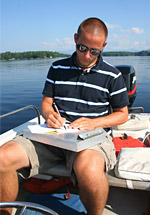
“I knew the lake pretty well before, but in the beginning, back at the end of May, I was nervous about rocks and buoys,” McClellan says. “Now I can get anywhere.”
What McClellan calls his worst day of the summer ended up involving boats. Until he attained the safe boaters permit required for a vessel over 25 horsepower, he used a smaller boat that went nowhere fast with a headwind.
“I got pretty beat up in that thing, with the waves and wind. Then I finally got this nice boat and the first time out with it, two miles from the dock, it started acting funny,” McClellan says. “I made it to a marina and called the center. There was only one person working and she asked if I had a paddle … there was no way that was going to work! The boat was in the shop for a month and a half and I was stuck with the old one again.”
On this August morning, though, the water is mirror-calm, the sun is hot, and the air is still. It beats being in an office, McClellan figures.
His Friends are Jealous
An office, however, is where McClellan hopes this internship will help land him one day. With a clear passion for resource management, he envisions a career in environmental policymaking.
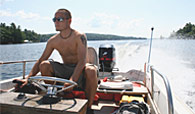
“Some of my friends are pretty jealous that for my internship, I get to drive a boat on one of the prettiest lakes around, but to be honest, I wouldn't want to do it for the rest of my life,” McClellan says. “I'd like to work with Washington [D.C.], but not in Washington; I'm not a big fan of politics.
“As long as what I'm doing eventually gets to the level where real national or international laws are being passed, I'll be happy. But you have to start local, which is what I'm doing here. A lot of the research LPC did affected legislation to outlaw lead sinkers; loons would swallow them and die. So change can definitely happen at the local level.”
Washington feels very far away from the mountain-ringed lake, though, and he's happy in the moment as he spots two pairs of loons. There are no babies with them, which means they are chickless for the season. One of the males yodels, and the boat moves on.
Caution, Baby Loons
The marina at Ambrose Cove is closed, but Melvin Bay's is open for business. Leaving there with a full tank of gas, McClellan heads across Moultonborough Bay to Langdon Cove, where a pair of loons has produced a chick. Still a brown puff ball, the baby sticks close to its parents but swims on its own instead of hitching a ride on a parent's back.
“My first chick hatched July 1,” McClellan says, guiding the boat through the shallow water. “There are about 40 loons on the lake not including juveniles, and eight pairs have chicks. They're getting big now; most are about three weeks old and developing nicely. It's fun to watch them grow.”

At the marshy rear of the cove, McClellan hauls yellow ropes marking a nesting area into the boat and covers a floating sign that reads “Loon nesting sanctuary, please stay away” with a bright orange message: “Caution, Baby Loons.”
Stowing the ropes, McClellan comments, “This internship has been my most rewarding job, but also the most challenging. Some people don't like what [the LPC is] doing; they think we're some radical group doing crazy stuff and preserving something that doesn't need preserving. Sometimes they don't like where we put these signs, but my job is to make people aware that they're sharing the lake with loons.”
The other day, he recounts, he was near an island watching a pair of loons when a boat passed between him, the shore and the birds within 100 feet. New Hampshire's safe passage law requires boats to maintain a 150-foot buffer from any other boats, floats, swimming areas and the shore when going faster than six miles per hour. After following the boater for five miles, McClellan eventually caught up and let him know that he'd passed much too close while going about 30 mph. The boater didn't react well to this information.
“He was like, 'Oh, I didn't know, I didn't see the loons until afterwards,' but I was sitting in a boat that says Loon Preservation Committee with loons 20 feet ahead of me. I was just doing my job by telling him that there are baby loons right now so you have to be really careful, but he thought I was lecturing him.
“I think a lot of people feel like we're trying to stop their fun, but we're not,” McClellan adds. “The point of our job is to make it so loons and people can coexist on this lake and both have healthy environments. The loons need the lake for nesting and people want it for summer fun. There has to be some kind of balance.”
Balance: Humankind & Nature

The coexistence of humankind and nature is often addressed in his CES courses, McClellan says. He cites Water Resources (CES201), which he took with Nick Baer, assistant professor of Natural Sciences, as a course that examines ecosystems with the goal of understanding humans' impact on water resources.
Pointing to two large new homes next to each other with manicured lawns that roll down to the water's edge, McClellan decries the bumper crop of multi-million-dollar houses lining the lakefront. He mentions another course he took at Colby-Sawyer, Desert Communities (BIO/CES 366), that clarified for him how people exploit water.
“People think it is OK to use thousands of gallons of water to have lawns in inappropriate locales such as deserts and lakesides. Water is such a huge resource that needs different, better regulations. I can't think of anything else that's more important than that,” he says, with the determination of someone set on making change in the treatment of the environment.
“Through my CES courses, I better understand the role of certain species in an ecosystem. If you tell someone on the street that loons are an indicator species they're not going to necessarily understand what that means,” he says,” but taking those classes shows how important the presence of biodiversity really is to an ecosystem.”
John Callewaert, McClellan's academic advisor and director of Colby-Sawyer College's Institute for Community and Environment, had the opportunity to observe McClellan at work on Winnipesaukee earlier this summer. What he saw is exactly what all faculty hope for with student internships.
“This is a great experience for Chris,” says Callewaert. “He's been able to learn important new skills as well as apply his knowledge of field research and natural history. Most importantly, though, I think this experience has shown Chris the importance of working with the local community for effective environmental management as well as the importance of groups like LPC.”
The World Around Us
In Buzzell Cove, a small C of water wrapped around an island, McClellan motors past the resident pair of loons floating near shore with their two chicks and heads for the nest he knows is hidden at the water's edge. Just a packed heap of dirt coated with twigs and bearing the indentations of the birds' bodies, the nest would be easy to miss and trample, but it still holds the shell fragments from the chicks' hatching. Collecting them in a plastic baggie, McClellan points out how key observational skills are to his work.
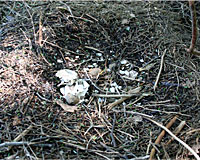
“I found this nest by accident when I just happened to see a loon enter the water and knew it had to be leaving its nest,” he says. “If you spend a lot of time on the water with the birds you get to know what their behavior means. If a loon were acting skittish and weird now, for example, you'd know that it probably had a chick and lost it.”
Always one to enjoy hiking and being in the woods, McClellan's appreciation for loons and their environmental challenges has increased over the summer, and he plans to check on the birds' progress in future summers.
“The more courses I take for the CES major, the more I appreciate what's around in the world,” he says. “People in general have to pay more attention to what's around them; most don't know what they're missing.”
Life and Death on the Lake
What people are missing, oftentimes, are the effects they and their actions have on the wildlife around them. Though the LPC successfully campaigned for a ban on lead sinkers, many fishermen still have some left over from before they were outlawed, and many more have sunk to the bottoms of lakes over the years. Ingesting lead is the leading cause of death for adult loons in New Hampshire, and McClellan has had to confront the slow death process, as described in his journal:
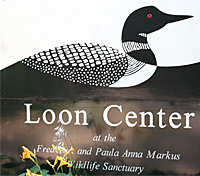
July 9: I got a call from lake residents reporting that a loon had beached itself at their house, a bad sign. I drove out there and spent a good half hour observing the loon. He let me get within two feet before he even raised his head. He was in an awkward position, with his head resting on his back. Occasionally, he would tremble and look around, blinking both sets of eyelids very slowly, not seeming to register anything going on around him. His lack of fear at my presence was unnerving, and I was almost 100 percent sure that he had ingested a lead sinker.
I had no materials with which to collect the bird, and did not know where I could take him if I got him in my car, so I called my supervisor. He came with a large net, a cardboard box, and several towels. The box was lined with water-soaked towels to keep the bird cool.
I slipped a dry towel over the bird's head and back to subdue him a little so I could get close enough to grab him. Then I carefully grabbed his beak and the back of his head so he wouldn't freak out and impale me, and John grabbed underneath his legs and lifted his body. Together we set him in the box, poured water on his feet to keep him cool, and made sure the towel was softly draped over his head to keep him calm. John took him to an animal hospital for x-rays but unfortunately, it was indeed a lead bird, and had to be put down - it was too late to save him.
The Work Goes On
Back at the Loon Center, McClellan fills out a biological collection report for the eggshell fragments, and an expense report for the tank of gas per day that the boat consumes. Surrounded by loon posters, stuffed birds and other loon paraphernalia, McClellan and his supervisor, John Cooley, talk easily about leg band color combinations, the high number of birds on the water that morning, and the plan for the rest of the day. There's been a report of a drifting sign, which McClellan will look for on his way across the lake; a homeowner's concern about another sign's placement has been addressed and the sign can go back in the water.
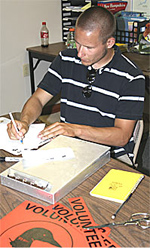
In the evening, McClellan will present a slideshow on the life history of the iconic bird at the Appalachian Mountain Club's Three Mile Island Camp. The next night, he will captain the boat on another lake for a banding trip from dusk until 3 a.m. (an early night). When he hears that a Fish and Game employee will be present, McClellan laughs and exclaims, “Good, she can net and grab its head!”
Banding seems simple, he explains, but it's actually a bit complicated. The loon is caught in a spotlight, which confuses it, and then scooped out of the water with a net.
“The beak is snapping and the bird's struggling,” McClellan says. “An adult male can weigh 15 pounds so we have to grab the head pretty quickly. It takes more guts to see this big bird in your boat and grab it than people might think. Then we work the bird up, measuring its bill and weight before snapping the band around its leg. We let it go in the same spot we netted it, and though a bit dazed, the birds always swim off OK.”
Cooley adds, “They don't teach you how to [do that or] change a boat's sparkplugs in any class!”
Though the LPC has not recruited at Colby-Sawyer before, and McClellan is the first student from the college to work at The Loon Center, Cooley says he would be happy to talk with other CES majors about the possibilities. McClellan's detailed paperwork, dedication and group-work experience at Colby-Sawyer have contributed both to a successful internship and to the LPC's research.
“This work has been totally new to me, and if I have another class where we have to do an exercise in the field or monitor something, I think the way in which I do it will be more efficient,” McClellan says. “My experience at LPC has really made me appreciate those who do field work for a living - the research is just as important as the work done by those who pass laws - but policy is where the action is and where decisions are made. That's where I want to be.”
Someday, no doubt, Chris McClellan will be making those big decisions, and will smile fondly anytime he hears a loon's wail and remember his summer on Lake Winnipesaukee as a Colby-Sawyer intern.
For more information about the Community and Environmental Studies major at Colby-Sawyer College, go to www.colby-sawyer.edu/academic/ces/index.html For more information about the work done by the Loon Preservation Committee, visit www.loon.org


